Tessa Fiorini Cohen – 5 years with Real Regulatory
Thank you to our Regulatory Affairs Consultant Tessa Fiorini Cohen for 5 years. Tessa has worked as a Regulatory Affairs Consultant for Real Regulatory Ltd since 2016. Tessa’s experience includes quality assurance, process and cleaning validation, and analytical development within the pharmaceutical industry, as well science communication within academia and media.
September 2020
Real CMC Tips and Insights
Since the beginning of July 2020, we have published weekly CMC tips and insights from our CMC experts on our Real CMC LinkedIn page, as a service to our followers. The tips we published in September 2020 are collected here, for convenience. Make sure you follow Real CMC and Real Regulatory Ltd for regulatory news, reports and hints.
SOPs in the Dossier
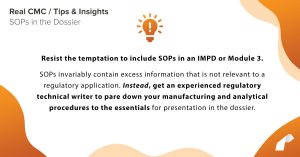
Reporting Impurities
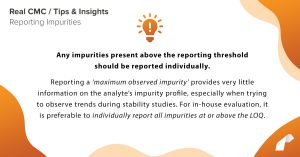
Dissolution Profiling of Biobatches
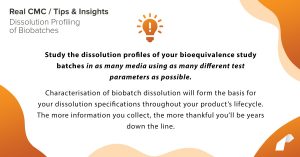
Specifications in the Dossier
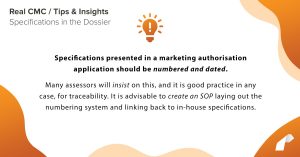
Polymorphism
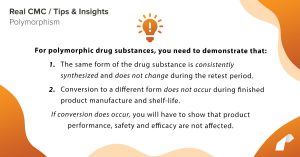
Last week’s round-up;
14 – 18 September 2020
Investigations in the GMDP environment
The MHRA Inspectorate has released a blog post on the most common issues related to investigations in the GMP and GDP environment that are encountered during inspections. The aim of the article is to help pharmaceutical manufacturers and wholesalers improve the outcome of their investigations, and it is applicable to deviations, customer complaints and other Pharmaceutical Quality System (PQS) activities. Several issues that may be encountered during investigations are covered, as well as the relevant implications on CAPA systems, risk assessments, patient safety and root cause analysis.
http://bit.ly/RealCMC-3hHkTfo
EMA: Clinical Data Publication temporarily suspended – except for COVID-19 related products
EMA suspended all new activities related to the publication of clinical data on 1st Aug 2018. This was done as a result of the implementation of the third phase of EMA’s business continuity plan during the relocation of its offices from London to Amsterdam. However, the agency has just clarified that the suspension of clinical data publication does not apply to COVID-19 related products, in line with EMA’s exceptional transparency measures for treatments and vaccines for COVID-19. Pharmaceutical companies should contact EMA as soon as possible concerning publication of clinical data if they plan to submit an application for a COVID-19 related product.
Further details can be found under this link: https://lnkd.in/dKsuUA3
EC: Proposed European agency for biomedical advanced research and development
The EC President Ursula von der Leyen yesterday (16th Sept 2020) gave her state of the union address, in which she called for lessons to be learned from the current pandemic. She asserted that Europe must build a stronger European health union, with a future-proof and properly funded EU4Health programme, a reinforced European Medicines Agency (EMA) and a strengthened European Centre for Disease Prevention and Control (ECDC). The President also pledged to build a European agency for biomedical advanced research and development to enhance Europe’s capacity to respond to cross-border threats and called for a debate on new competences for the EU in the field of health, as part of the forthcoming Conference on the Future of Europe.
Full details of the address can be found under this link https://lnkd.in/gfEZ8sE
USP General Chapter <1469> Nitrosamines – Public consultation
A new USP general chapter <1469> Nitrosamines has been proposed. The aim of this standard is to ensure the appropriate control of potentially carcinogenic nitrosamine impurities, eliminating or reducing their presence in drug products and drug substances. This USP chapter also covers potential sources of nitrosamines, risk assessments, nitrosamine limits, testing and analytical procedures, test method performance characteristics of nitrosamine methods and USP reference standards. The chapter has been published in draft form in Pharmacopoeial Forum 46(5) and is open for public consultation until the 30th November 2020.
https://bit.ly/RealCMC-33NQirF
Biotherapeutics Ph. Eur. Monographs Updates
The EDQM has updated its Ph. Eur. monograph portfolio on Biotherapeutics. Several monographs are under revision and the EDQM intends to emphasise “greater flexibility as a means of better addressing the structural complexity and naturally occurring heterogeneity of these substances, and the potential diversity of the preparation resulting from different manufacturing processes”. Several individual Ph. Eur. monographs are also under revision including Erythropoietin concentrated solution, Follitropin, Follitropin concentrated solution, Human coagulation factor VIII rDNA, Somatropin concentrated solution, Somatropin, Somatropin for injection and Somatropin solution for injection. The Ph. Eur. Biotherapeutics portfolio also includes a list of new monographs that are currently in preparation. Since the portfolio was published, the revised version of Erythropoietin concentrated solution (1316) monograph has been adopted. The updates include several changes which bring about a significant improvement in the analytical performance of the monograph, while also providing the sought-after flexibility. The updates to the monograph are discussed in the following link:
https://bit.ly/32xVMHD (more…)
Last week’s round-up;
07 – 11 September 2020
Qualification of Balances – EDQM Guidance
The EDQM has revised its “Qualification of Balances” guideline. The document is the 8th Annex to the OMCL Network Guideline “Qualification of Equipment”, and it has entered into force as of September 2020. The 8th Annex should be used in conjunction with the core guideline “Qualification of Equipment” when planning, performing and documenting the qualification process of balances. The core document contains the general introduction and Levels I and II of qualification pertaining to all types of instruments, while the 8th Annex contains a general introduction and requirements for balances (electronic – digital) used in official medicines control laboratories for physicochemical and biological tests. The revised guideline covers ultra-micro balances, micro balances, semi-micro balances, analytical balances, precision balances and technical balances.
http://bit.ly/RealCMC-3ix12As
Comparator products in studies supporting UK MAAs from 01-Jan-21
According to new guidance published on 1 September 2020, the UK MHRA will allow the use of comparator products sourced from outside Great Britain for studies supporting abridged MAAs (but not biosimilars), to avoid unnecessary repetition of bioequivalence and therapeutic equivalence studies. All EEA countries, Switzerland, USA, Canada, Australia and Japan are acceptable source countries. An applicant choosing this option must demonstrate that the non-GB comparator product is representative of the GB reference product. The nature of the analytical bridging data to be provided is described in considerable detail in the guideline. Minor differences between the comparator product and the GB reference product can be accepted, e.g. colour.
http://bit.ly/RealCMC-33a9nUq
EMA Workshop on the draft guideline on registry based studies
EMA has published an agenda for their upcoming workshop on the draft guideline on registry based studies. The key objectives of the workshop are
1. To respond to key questions and requests for clarification,
2. To present stakeholders’ perspectives on the usefulness of the Guideline for registry-based studies, and
3. To present recent experience on methodological aspects of registry-based studies.
The workshop takes place on 19th October on a virtual basis, further details can be found under this link: https://lnkd.in/ebhsM-y
(more…)
Last week’s round-up;
31 August – 04 September 2020
FDA issues nitrosamine detection and prevention guidance
The US FDA has implemented new nitrosamine guidance with immediate effect. The document details the necessary steps that should be taken to detect and prevent the introduction of potentially carcinogenic nitrosamine impurities into finished drug products and active pharmaceutical ingredients (APIs). The guidance describes circumstances that can lead to the introduction of nitrosamine impurities in medicines and APIs. This includes the potential roles of tertiary and quaternary amines used as reagents during the manufacturing process and which may be a potential source of nitrosamines, as well as amide solvents that can be a source of secondary amines. The guidance also covers circumstances in vendor-sourced materials where recovered solvents, catalysts and reagents may be a source of nitrosamine contamination. Risk assessment processes are also laid out in the guideline.
Further information on the new FDA guidelines may be viewed at the following link: http://bit.ly/RealCMC-3bpTOvz
Public Consultation on the CEP of the future
The EDQM has launched a project to design the Certificate of Suitability (CEP) of the future. The content and layout of the current CEP have not changed significantly since the original CEP was created in 1992. The aim of the project is “to develop a “new-look” CEP that will better fit the emerging needs of stakeholders and offer both enhanced user-friendliness and greater transparency of the information conveyed without, however, increasing the administrative regulatory burden related to their revision”. Therefore, the EDQM is requesting general feedback on the content, layout, format and use of the CEP from stakeholders in the pharmaceutical industry and from National Competent Authorities around the world. Stakeholders may submit their comments in the form of an online survey until 31st December 2020. A “read only” version of the survey is also available in order to allow users to prepare their answers in advance: https://bit.ly/RealCMC-3jFpaBi
MHRA publishes New Rules to apply from January 2021
MHRA has published Guidance for industry and organisations to follow from 1 January 2021 following the transition period when UK fully exits the EU. The guidance covers the requirements for Clinical Trials, Devices, Licensing, Importing and Exporting, IT systems, Pharmacovigilance and Paediatrics.
The link to the guidance can be found here: https://lnkd.in/e7mstgx
New FDA product-specific guidance
The US FDA has published 19 new and 17 revised product-specific guidances, which clarify the agency’s expectations for demonstrating equivalence between generic and reference drugs, in an effort to promote generic competition. The new draft product-specific guidances include recommendations for generic versions of the breast cancer drug alpelisib, generic esketamine which is a nasal spray for treating major depression and larotrectinib, which is used to treat solid tumors with neurotrophic receptor tyrosine kinase gene fusions. The following product-specific guidance documents were revised: generics of the blood clot drug rivaroxaban and several HIV treatments, including dolutegravir, and the combination products abacavir/dolutegravir/lamivudine and dolutegravir/rilpivirine: https://bit.ly/RealCMC-2EKeLFD
ENPR-EMA: Preparedness of medicines’ clinical trials in paediatrics
Enpr-EMA issues recommendations on preparedness, for sponsors, principal investigators and triallists involved in paediatric clinical trials. They have defined ‘Preparedhttp://bit.ly/RRL-2DziLrQness’ as the structured assessment of contributing factors that enable the smooth conduct of CTs in a timely manner. The recommendations cover data and information collection, contributor involvement (such as CT sites, expert groups , patients and families, and regulators), following a structured approach, and approaches for preparing plans and studies.
A link to the full document can be found here: https://lnkd.in/fSahvZK
EMA Consultation issued: QT/QTc Q&A
EMA has issued a consultation on the ICH Guideline E14/S7B Implementation working group document: Clinical and Nonclinical Evaluation of QT/QTc Interval Prolongation and Proarrhythmic Potential Questions and Answers. The document comprises proposed revisions to sections 5.1 and 6.1 of the current Q&As for ICH E14. Other sections are not proposed for revision. At Step 4, the revised sections 5.1 and 6.1 will be integrated with the other current Q&As for ICH E14. The consultation also includes new Q&As for ICH S7B.
A link to the consultation can be found here: http://bit.ly/RRL-2DziLrQ
FDA addresses nitrosamines in TB drugs
Following the discovery of elevated levels of nitrosamine impurities in two tuberculosis drugs, rifampin and rifapentine, the FDA has clarified how it will address the presence of these potentially carcinogenic impurities. Elevated levels of the nitrosamine 1-methyl-4-nitrosopiperazine (MNP) were found in rifampin and high levels of 1-cyclopentyl-4-nitrosopiperazine (CPNP) were found in rifapentine. The Agency has taken a risk-benefit approach to the issue and has said that “to mitigate or avoid shortages and to help ensure patients have access to these necessary medicines, FDA will not object to certain manufacturers temporarily distributing” rifampin and rifapentine containing nitrosamines above the acceptable intake limits “until they can reduce or eliminate the impurities”. Manufacturers should however ensure that levels of the MNP and CPNP in these antibiotics are below 5 ppm and 14 ppm respectively. In cases where nitrosamine levels are found to be above these limits, the manufacturer is required to contact the Center for Drug Evaluation and Research’s Drug Shortage Staff who will determine whether the products should be released for distribution. http://bit.ly/RealCMC-31FOLUA
(more…)
Last week’s round-up;
24 – 28 August 2020
Aseptic Processing Practices: Reviewing Three Decades of Change
Thought-provoking article by Agalloco, Akers and Madsen highlighting challenges that are emerging for 2020 and beyond for aseptic processing and arguing that it is time to revise the pharmaceutical industry’s expectations and approaches to validation. In the authors’ own words, “Technologies in use and on the horizon could change aseptic processing in ways that seemed inconceivable years ago but approaches to aseptic process validation still need to move beyond their 1970s roots.”
http://bit.ly/RealCMC-2Qyzxu0
EMA’s Lapatinib product-specific bioequivalence guidance
The EMA has released a 2nd draft of its product specific guidance on the demonstration of the bioequivalence of lapatinib 250 mg film-coated tablets. The guidance was extensively revised following the first public consultation. Stakeholders may submit their comments on the revised draft guidance by the 30th October 2020.
https://bit.ly/2ZOgRuu
EMA interactive guidance on IRIS access
The EMA has released an interactive presentation on how to register for their IRIS system, which gives a step by step guide to gaining access, and also information on some submission-specific requirements.
https://lnkd.in/eTNtJGa
MHRA reflection on cross-contamination control
The MHRA has shared its reflections on some of the common factors in critical deficiencies found in control strategies for cross contamination between products in shared facilities. The Agency’s expectations are focussed mainly on sites handling products with lower level Health Based Exposure Levels (HBELs), those with products around the red area of the continuum seen in the PIC/S Q&A document. The MHRA has highlighted the following aspects that companies are required to address:
• HBELs should be completed by experienced professional toxicologists for all products
• The HBEL value and hazard knowledge should be used to set the context and the reference for conducting Quality Risk Management development of Organisational and Technical controls
• Companies may rely solely on visual inspection for cleanliness at changeover between products following cleaning validation, only when there is clear and safe evidence that residues can be consistently and readily seen at the acceptance criteria level
Further details on the MHRA’s expectations may be viewed at the following link: https://bit.ly/RealCMC-2CVqm3F
Nitrosamines risk assessment: update for CEP holders
The EDQM has decided not to extend the deadline of 31st July 2020 for CEP holders to submit step 1 of the nitrosamine risk assessment for their APIs. The Directorate has said that “risk assessments for the presence of nitrosamines in active substances should be available early enough to allow MAHs to collect the relevant data for their medicinal products. In addition, most CEP holders have already completed this step.” CEP holders who have yet to submit their risk assessment and need support are required to contact the EDQM as soon as possible and should propose a justifiable timeline. As of 1st October 2020 applicants and CEP holders are also required to include a risk assessment regarding the potential formation of nitrosamines in any new CEP application, sister file or renewal application, and also in any revision where a risk of nitrosamine formation may be introduced. Applicants are advised to include the risk assessment in the CEP submission, even in cases where a risk is not identified.
http://bit.ly/RealCMC-34qStDe
(more…)
Last week’s round-up;
17 – 21 August 2020
EUDAMED- use of actor registration module and Single Registration Number (SRN)
The European database on medical devices (EUDAMED) is an IT system developed by the EC to implement the MDR. EUDAMED will consist of multiple electronic systems (so called ‘modules’) including an electronic system on registration of economic operators, also referred to as the actor registration module. The actor registration module allows for the creation of a unique single registration number (SRN) for the purpose of identifying the manufacturer, and where applicable the authorized representative and the importer. Full functionality of EUDAMED is delayed until 2022 however the Commission has confirmed its readiness to deploy the first module namely the actor registration module as of 1 December 2020.
The Medical Device Coordination Group (MDCG) position paper linked here https://bit.ly/32h2X5k strongly encourages the use of the actor registration module by all relevant actors in their territories including the use of SRN as stipulated in the MDR as of 1 December 2020.
Revised EMA guidance on pyrrolizidine alkaloids in herbal medicines
The EMA has revised its draft ‘Public statement on the use of herbal medicinal products containing toxic, unsaturated pyrrolizidine alkaloids (PAs) including recommendations regarding contamination of herbal medicinal products with pyrrolizidine alkaloids’. Pyrrolizidine alkaloids are found naturally in some plants and several PAs are regarded as both hepatotoxic and carcinogenic. The document contains the EMA’s recommendations for the oral and cutaneous use of herbal medicinal products and traditional herbal medicinal products containing PAs. The guidance describes the chemical, toxicological, pharmacological and pharmacokinetic properties of these impurities.
http://bit.ly/RealCMC-2QddQzz
Resuming UK on-site inspections – MHRA expectations
The MHRA intends to resume an on-site UK risk-based GxP inspection programme in September 2020, following a reduction in restrictions brought on by the COVID-19 pandemic. The Agency plans to scale up to a full programme as of October 2020. In view of this, the MHRA has released guidance for the industry to ensure that the on-site inspections are carried out safely and in accordance with the current government guidelines on COVID-19 mitigation. The guideline covers various aspects of GxP inspections including the necessary planning required prior to the inspection, guidance related to the conduct of the actual on-site inspection and also post-inspection guidance.
The full guideline may be viewed at the following link: https://bit.ly/RealCMC-3aHbyC7
ICHQ12: A European Perspective
The much-anticipated ICH guideline Q12, dealing with post-approval changes to chemistry, manufacturing and controls (CMC), has been released in its final version. However, in Europe this has come with a disappointing catch. It cannot be fully implemented due to the current EU legal framework. Our new article outlines the guideline’s main principles and highlights what can and cannot be implemented within the EU at this time.
Read it here: https://lnkd.in/eCHkdJE
MHRA Analytical QbD consultation
The MHRA has concluded its consultation on the application of Analytical Quality by Design (AQbD) principles to pharmacopoeial standards for medicines in collaboration with the industry. The Agency has identified the following four strategic objectives which will be delivered through a dedicated work programme:
• To develop and publish new standards and guidance.
• Further explore the application of AQbD concepts.
• Build capability across the Agency.
• Engage and collaborate with stakeholders.
Further information on the outcome of the MHRA consultation may be found at the following link: https://bit.ly/RealCMC-3aLi37j
MHRA Inspectorate Blog: Data on Serious Breaches of GCP
In 2019, MHRA received a total of 112 serious breach of GCP notifications, of which 75 were deemed to be a serious breach, 36 deemed not to be a serious breach, and 1 is yet to be resolved. MHRA has also just updated the associated notification form and guidance so that the quality and completeness of the submitted information is sufficient to allow full assessment and determination of the breach.
Full details can be found under this link: https://lnkd.in/dGedBWY
Possible impurity in paracetamol and CEP validity update
Paracetamol manufactured by a particular company holding a certificate of suitability was reported to be possibly contaminated with the mutagenic impurity 4-chloroaniline (PCA), a known impurity that may be formed during the manufacturing process of this active ingredient. However, an investigation carried out by the EDQM has shown that the levels of PCA in this active ingredient were well below the acceptable limits. Therefore, the CEP for paracetamol from the concerned manufacturer is still valid as the safety of the active ingredient has not been compromised.
https://bit.ly/RealCMC-3j0kshl
(more…)
Last week’s round-up;
10 -14 August 2020
Evaluation of the medicines for rare diseases and children legislation
On 11 August 2020, the EC published an evaluation of the EU orphan and pediatric regulations, adopted in 2000 and 2006, respectively. Following an evaluation comprising several steps, the regulations were analysed according to five criteria: effectiveness, efficiency, relevance, coherence; and EU added value. It was concluded that the regulations met their main objectives of increasing the number of products for patients with rare and paediatric diseases in the EU. Conversely, however, issues were recognised including: · Products may not be equally accessible across the EU or affordable to national health systems; · Circumstances may have changed since the regulations were introduced; · The regulations do not have instruments to counteract observed clustering of products leaving areas of unmet need, or to direct development to areas most relevant to children; · The concept of prevalence as a tool to receive orphan designation and the length of the 10-year market exclusivity period may need to be re-examined. Looking forward, it was noted that some of the issues identified are closely linked to and will be tackled by the Pharmaceutical Strategy for Europe.
https://lnkd.in/daqjhgh
EMA addresses risk evaluation, mitigation for nitrosamines
The EMA has updated its Q&A document on nitrosamine impurity testing for marketing authorisation holders. MAHs need to perform a risk evaluation to determine whether chemically synthesized active pharmaceutical ingredients are at risk of containing nitrosamines by 31 March 2021 (extended deadline). This same requirement has now been extended to biologicals, with a deadline of 1 July 2021. Biologicals considered particularly at risk include those containing chemically synthesized fragments, those where nitrosating reagents are added, and those packaged in nitrocellulose blister packs. The document includes further deadlines for confirmatory testing where applicable, as well as related variation submission requirements. It also delineates specific requirements for analytical methods to be used in testing, mitigation measures when nitrosamines are detected, and daily acceptable limits for various nitrosamines.
https://bit.ly/RealCMC-2XSGoCR
Tackling serious impurities
Discovery of N-nitrosamines in a variety of medicines over the last two years could have a much wider impact on pharmaceutical manufacturers and regulators than previously expected. The underlying issue in all N-nitrosamine contamination cases was inadequate control of impurities, and so European Union regulators want manufacturers and national regulators to take more effective action in tackling all potentially carcinogenic impurities in APIs and finished products. This decision arises from results published by a ‘lessons learnt’ group within the EU medicines licensing network. The group has proposed a variety of guidance reviews, including those relating to marketing authorization holders, finished product and API manufacturers, active substance master file and CEP holders. Updates to ICH M7 and the EU’s good manufacturing practice guidance have also been proposed.
https://bit.ly/RealCMC-2DNXhax
GMP inspectorate audits, Brexit stockpiling, and MHRA’s Covid-19 divergences
The EMA’s Mutual Recognition partners can now take part in audits of the GMP inspectorates of national authorities. MRA partners could previously participate in audits as observers and, from now on, will also be able to participate as co-auditors if they express an interest in doing so. However, MRA partners still won’t be able to serve as lead auditor, as this role is reserved for European groups. In other regulatory news, the UK government has asked industry to stockpile medicines ahead of the next Brexit deadline at the end of the year. The MHRA has also highlighted nine areas where its COVID-19 flexibilities diverge from EU policies. The list includes MHRA’s positions on qualified person declarations, the 30-day limit for type 1B variation replies, leaflet mock-ups and over-labelling.
https://bit.ly/RealCMC-2PL1LBi
Endotoxin levels in investigational cancer treatments
The US FDA has released new draft guidance on setting limits for endotoxins during the clinical trial process for parenteral oncology drugs intended for serious and life-threatening cancers. This new document provides risk-based guidance on endotoxin limits for investigational therapies that are used in early clinical trials in conjunction with other approved treatments or with other investigational medicines. Patients’ possible exposure to endotoxin levels exceeding USP recommendations may be considered an acceptable risk under appropriate circumstances.
https://bit.ly/RealCMC-3ipJZzX
(more…)
Last week’s round-up;
27 -31 July 2020
Country-specific requirements update for MRP/DCP variations and/or renewals
The CMDh has revised its “Data requested for Variations and/or Renewal Applications in the MRP/DCP which are not stated in the current EU legislation and/or in Volume 2B, Presentation and format of the dossier Common Technical Document (CTD) and/or in the EEA approved Guidelines/ Recommendation papers” document. Croatia has now been removed from the list, which indicates that Croatia does not have any country-specific requirements for Variations and/or Renewal Applications related to the MRP/DCP.
https://bit.ly/RealCMC-2Pf1XIM
Updated Services Section
We have updated the Services section of our website. Do have a look!
Our experienced and dedicated consultants can help you no matter what phase of development.
Chat to us today: https://www.realregulatory.com/services//
Revision of Ph.Eur. Sieve Test
A revised Ph. Eur. Chapter 2.9.12 Sieve Test has been published in Pharmeuropa 32.4. The chapter was revised in response to comments received to a previous proposed revision of the chapter that was released in Pharmeuropa 20.4 and 22.4. The chapter was previously revised to adapt it to the newer harmonized general chapter 2.9.35 Powder fineness, which provides a classification of powders according to their degree of fineness.
https://pharmeuropa.edqm.eu/internal/ec884bbe9cd54f27aa8b53911cd6ace4/phpa/issue32-4/page/20912E.pdf
EDQM Clarification on revision of CEP applications
The EDQM has issued some clarifications on the revised ‘Guideline on requirements for revision/renewal of certificates of suitability to the European Pharmacopoeia Monographs’, which was introduced in January 2019. In the announcement the EDQM provides clarifications on several situations involving the revision/renewals of CEPs, including:
· When a new substantially different route of synthesis is introduced.
· Where different grades of material with different specifications are involved.
· Misclassification of minor/major revisions by CEP holders.
https://bit.ly/RealCMC-3jFXRYi
EMA requirements for the qualification and validation of computerised systems for CT data.
EMA published a notice for clinical trial sponsors to highlight the requirements for the qualification and validation of computerised systems used for managing clinical trial data. This is based on inspection findings and based on the implications on the integrity, reliability, robustness and acceptability of data in future MAAs.
EMA has also updated associated questions 8 and 9 on their Q&A, which can be found here: https://lnkd.in/gjrgWM7
CMDh Q&A – QP Declaration Update
The CMDh has revised its QP Declaration Q&A guidance. The document includes an update to guidance on QP declaration requirements in situations where a CEP or ASMF has two manufacturing sites but the MAH just wishes to approve one of the sites.
The updated document with tracked changes may be viewed at the following link: https://bit.ly/RealCMC-2X029Qw
(more…)
Last week’s round-up;
20-24 July 2020
MHRA News: Medical Device “Certificates of Compliance” / “Attestation of Conformity” have no legal standing under MDR
Certificates of compliance or Attestation of Conformity documents have no legal standing under the UK Medical Device Regulations 2002 (UK MDR). They are not evidence that the manufacturer of the device has met the requirements of the UK MDR, nor are they CE Certificates. The certification body may have issued these following a review of the technical documentation for the medical device. However, this is not a regulatory requirement and so the certificate issued has no regulatory validity. Evidence of registration and declaration of conformity are documents of regulatory validity and may be requested from the manufacturer or the EU Authorised Representative.
https://bit.ly/RealRegulatory-2OTldvu
New EMA guideline on Water quality for pharmaceutical use
The EMA has issued a new guideline on the quality of water for pharmaceutical use that will replace its current guidance and position statement on water quality when it takes effect in February 2021. The new guideline applies to the manufacture of active substances and drug products for both human and veterinary use, ATMPs and where relevant, to IMPs, and should be consulted for new marketing authorization applications and variations to existing authorizations.
Recommendations are provided with respect to the minimum acceptable quality of water for different uses and applications, including the manufacture of sterile and nonsterile medicinal products, active substances and water used for cleaning and rinsing equipment and containers/closures for pharmaceutical products. This new guideline should be read in conjunction with EMA’s 2017 Questions and answers on production of water for injections by non-distillation methods – reverse osmosis and biofilms and control strategies document.
https://bit.ly/RealCMC-39nJdQM
EC has issued an updated draft Q&A on the Clinical Trials Regulation (CTR)
EC has issued an updated draft Q&A on the Clinical Trials Regulation (CTR). Updates to this draft document are as follows:
-
- Section 1 on the scope of the CTR question 1.7 details clarification on what is not considered normal clinical practice and 1.19 details language requirements and an associated Annex II.
- Section 2 changes concern the processes for the subsequent addition of a Member State.
- Section 3 details an updated 3.4 concerning the timing of submission of modifications.
There are various modifications to section 7 on safety reporting and it includes a new question 7.19 which clarifies how RSI for the development of biosimilar drug products should be written.
https://bit.ly/RealRegulatory-2ZWWUTH
MHRA to return to on-site GxP Inspections
MHRA is currently making careful preparations for a safe return to normal UK on-site inspection scheduling. During the last few weeks they have been engaging with industry trade associations and the NHS to discuss the practical arrangements that may be required to facilitate on-site inspection starting in September and scaling up to a full programme from October 2020. The conduct of the inspections will vary according to the requirements of each GxP area and may include a hybrid model of on- and off-site activities that support a single inspection cycle.Further information will be made available later in the summer. Details of the announcement can be found here: https://lnkd.in/gFDKy69
Pharmeuropa 32.3 Public Consultation
Pharmeuropa 32.3 is now available for public consultation and includes 48 new and revised draft texts. A list of the draft texts is available for perusal at the link below, and it includes draft monographs on Raman spectroscopy, Extractable elements in plastic materials for pharmaceutical use and Cyclo-olefin polymers. These draft monographs are not currently considered official standards, however, once they are adopted by the Ph. Eur. Commission they will become applicable and the legally binding standards for the products concerned in all Ph. Eur. member states. Users should submit their comments by the 30th September 2020.
https://bit.ly/RealCMC-32M31vT
EMA sets up infrastructure for real-world monitoring of COVID-19 treatments and vaccines
EMA has set up an infrastructure to support the monitoring of COVID-19 treatments and vaccines when used in day-to-day clinical practice. This is underpinned by three contracts for observational research that EMA has signed with academic and private partners, to be ready to effectively monitor vaccines performance in the real world, and to support the safe and effective use of both vaccines and medicines.The latest contract was finalised in mid-July with Utrecht University and the University Medical Center Utrecht as coordinators of the CONSIGN project (‘COVID-19 infectiOn aNd medicineS In preGNancy’).
This project will collect data on the impact of COVID-19 in pregnancy. In June, EMA contracted the company IQVIA with a project to build a framework for the conduct of multicentre cohort studies on the use of medicines in COVID-19 patients. In May, EMA commissioned the ACCESS project (‘vACcine Covid-19 monitoring readinESS’) for preparatory research into data sources and methods that can be used to monitor the safety, effectiveness and coverage of COVID-19 vaccines in clinical practice, once authorised.Full discussion on the supportive infrastructure and other aligned collaborations, can be found here: https://bit.ly/30zpNV2
Quality Risk Management – Transportation Risks
Quality Risk Management (QRM) in transportation tends to be a significant weakness for many wholesalers, according to the MHRA inspectorate. A new blog post by the department details one practical approach for ensuring good transportation QRM, based on the theory within ICH Q9. It covers risk assessment, control, communication within and outside the organisation, and periodic review. Common weaknesses seen by inspectors are also listed, such as QRM not being understood by managers or being used as an excuse to avoid developing appropriate mitigation: https://bit.ly/RealCMC-2WHttTB
Medical Device Coordination Group (MDCG) issues a template for Clinical Evaluation Assessment Reports
MDCG has issued a new template for clinical evaluation assessment reports, which will be used by NBs to clearly document the conclusions of its assessment of the clinical evidence presented by the manufacturer in the clinical evaluation report (CER) and related clinical evaluation that was conducted. This is a core requirement of the Medical Device Regulation (EU) 2017/745 (MDR). As part of the assessments performed NBs will assess the suitability of using data from claimed equivalent devices, clearly document its conclusions on the claimed equivalence, and on the relevance and adequacy of the data for demonstrating conformity.
The NB will verify that the clinical evidence and the clinical evaluation are adequate and shall verify the conclusions drawn by the manufacturer on the conformity with the relevant general safety and performance requirements. Finally the NB will consider the clinical evaluation and the benefit-risk determination, and whether specific milestones need to be defined to allow the notified body to review updates to the clinical evidence that result from post-market surveillance and PMCF data. The document in full can be found here: https://lnkd.in/dftjZyD
Public consultation extension of Ph. Eur. nitrosamine analysis chapter
Following the closure of the public consultation for the new Ph. Eur. general chapter on the analysis of N-nitrosamine impurities in active substances (2.4.36), the EDQM is now accepting comments from stakeholders who were not able to take part in the consultation due to restrictions brought on by the COVID-19 pandemic. The general chapter proposes three procedures relying on GC-MS, LC-MS/MS and GC-MS/MS analytical techniques, which cover seven N-nitrosamine impurities. The stakeholders concerned are required to contact their respective national pharmacopoeia authority (NPA) or the EDQM as soon as possible in order to announce their intent to comment. Comments will be received until the 31st August 2020.
https://bit.ly/RealCMC-2CQU1uF
(more…)






